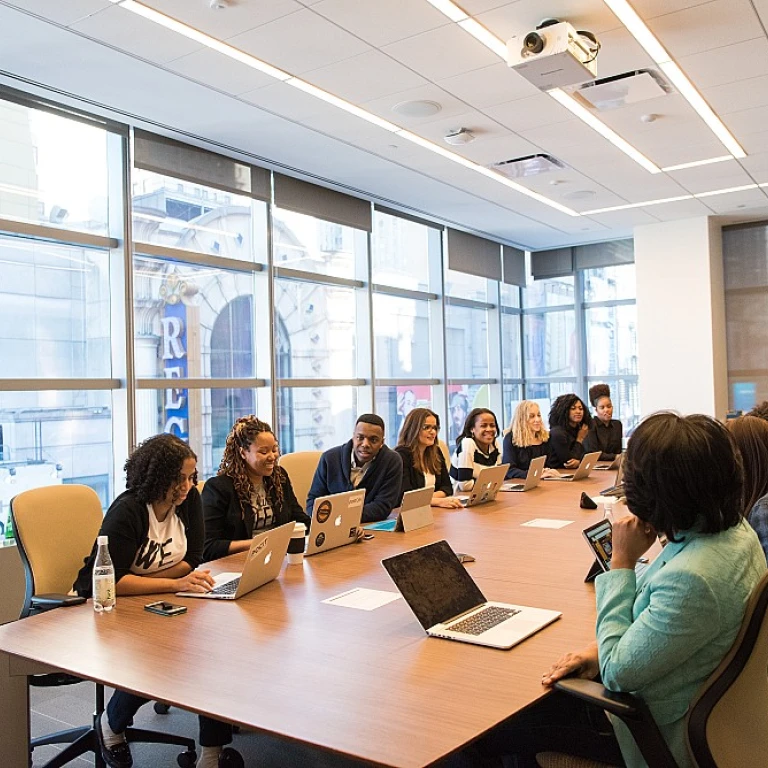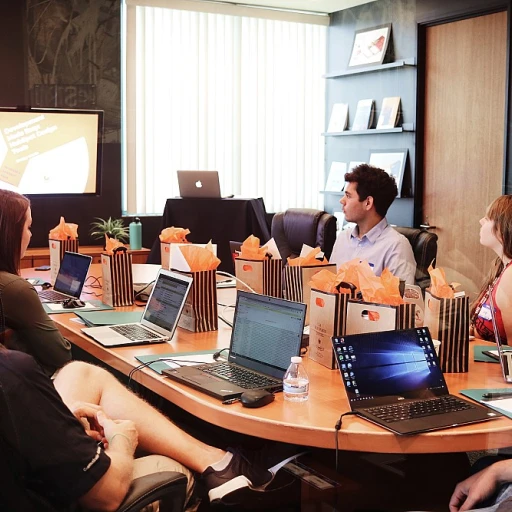
Understanding Internal Hiring
Grasping the Dynamics of Hiring from Within
The concept of internal hiring refers to the practice of filling vacant positions within a company by recruiting existing employees. It's a familiar process within many businesses, as it often nets a quicker turnaround time and can fill roles with less external recruitment hassle. This strategy allows companies to leverage existing talent, providing opportunities for career advancement among their internal candidates.
However, understanding internal hiring isn't merely about facilitating a simple transfer or promotion. It's about integrating a comprehensive internal recruitment process, ensuring the correct match between the candidates and their prospective roles. Internal recruitment can often be thought of as a double-edged sword in the realm of talent acquisition. While it may save time in the hiring process and helps avoid the costs typically associated with external hires, it does present distinct challenges that necessitate careful consideration.
For instance, when businesses rely too heavily on hiring internally, they may miss out on fresh perspectives and new skills that could be brought in by external candidates. Moreover, if not managed correctly, prioritizing internal hires could inadvertently foster feelings of favoritism or limit diversity within the company, making it vital to balance internal and external hiring practices.
Ultimately, internal hiring's best scenarios typically involve unique positions where existing employees would have company-specific knowledge, creating an advantage over external recruits. Plans that implement reskilling strategies effectively can greatly bolster the potency of internal hiring practices, ensuring that internal candidates are not only capable fits for the new role but are also given a fair and equitable footing when competing alongside external candidates.
As the hiring practices continue to evolve, the question becomes: how do companies refine internal recruitment processes to complement external recruitment efforts while maintaining an edge in the workforce development arena? Delving into the nuances of internal and external hiring, and the overarching importance of workforce development, remains essential. For more insights on unraveling the complexities of workforce development, consider exploring this informative guide.
The Reskilling Imperative
The Growing Need for Skill Development
In today's rapidly evolving job market, the need for reskilling has become more pronounced than ever. Companies are recognizing that to stay competitive, they must invest in their existing employees. This means not just filling positions through internal hiring, but also ensuring that these internal candidates are equipped with the necessary skills to excel in their new roles.
Reskilling is not just a buzzword; it's a strategic imperative. As businesses face the dual challenges of technological advancements and changing market demands, the ability to adapt is crucial. This adaptation often requires a shift in skills, which can be more efficiently achieved through reskilling existing employees rather than relying solely on external recruitment.
Why Reskilling Matters
Reskilling offers several benefits that align with the goals of both the company and its employees. For businesses, it helps in reducing the time and cost associated with the hiring process. Instead of spending resources on external hires, companies can focus on developing the talent they already have. This not only enhances employee loyalty but also ensures a smoother transition into new roles.
For employees, reskilling provides an opportunity to grow within the company. It allows them to take on new challenges and advance their careers without the need to seek opportunities elsewhere. This is particularly important in an era where job security is a major concern for many workers.
Integrating Reskilling into Hiring Practices
To effectively integrate reskilling into hiring practices, companies should establish clear policies and processes. This includes identifying the skills that are in demand and creating targeted training programs to address these needs. By doing so, businesses can ensure that their internal recruitment efforts are not just about filling positions, but about building a workforce that is equipped for the future.
For a deeper understanding of how reskilling fits into workforce development, consider unpacking the abbreviations in workforce development. This resource provides insights into the various components of effective reskilling strategies.
Challenges of Internal Hiring
Overcoming the Hurdles of Internal Hiring
While internal hiring offers several advantages, it also presents unique challenges that companies must navigate. Understanding these challenges is crucial for businesses aiming to optimize their recruitment strategies and effectively fill roles with the best talent.
One of the primary challenges is the limited talent pool. When a company focuses solely on internal candidates, it restricts the diversity of skills and perspectives that external recruits might bring. This can lead to a lack of innovation and fresh ideas within the organization.
Another issue is the risk of internal bias. Managers and HR professionals may have preconceived notions about existing employees, which can influence the hiring process. This bias can result in overlooking potential talent or promoting individuals who may not be the best fit for the new role.
Moreover, internal recruitment can sometimes lead to disruption within teams. Moving an employee from one position to another might leave a gap that needs to be filled, creating a domino effect of vacancies. This can increase the time and resources needed to stabilize the workforce.
Additionally, there is the challenge of adequate reskilling. Internal candidates may require significant training to transition into new roles effectively. This process can be time-consuming and costly, especially if the company lacks a structured reskilling program. For insights into effective reskilling strategies, you can explore navigating the path to talent mobility.
Finally, balancing internal and external hiring is crucial. While internal hires can fill immediate needs, external recruitment is often necessary to bring in new skills and perspectives. Companies should strive to create a harmonious blend of both approaches to ensure a dynamic and adaptable workforce.
Reskilling Strategies for Internal Candidates
Developing Effective Reskilling Programs
Reskilling internal candidates is not just about filling a role; it’s about equipping existing employees with the skills they need to thrive in new positions. Companies should focus on creating structured programs that align with both business goals and employee aspirations. This ensures that the internal recruitment process is not only efficient but also beneficial for long-term talent acquisition.
Identifying Skills Gaps
Before implementing any reskilling strategies, it’s crucial to identify the skills gaps within the organization. This involves assessing the current capabilities of employees and comparing them with the skills required for future roles. By doing so, businesses can tailor their reskilling efforts to meet specific needs, making the internal hiring process more effective.
Leveraging Technology and Training
Technology plays a vital role in reskilling. Online courses, webinars, and virtual workshops can provide employees with the flexibility to learn at their own pace. Companies should invest in platforms that offer a wide range of courses, allowing internal candidates to acquire new skills relevant to their desired positions. This approach not only enhances the internal recruitment process but also prepares employees for external recruitment challenges.
Creating a Supportive Learning Environment
For reskilling to be successful, companies must foster a culture of continuous learning. Encouraging employees to take ownership of their development and providing them with the necessary resources can significantly impact the effectiveness of reskilling strategies. This supportive environment ensures that internal candidates are well-prepared for new roles, ultimately benefiting the company’s hiring practices.
Measuring Success and Adjusting Strategies
Finally, it’s essential to measure the success of reskilling initiatives. Companies should track the progress of internal hires and assess how well they adapt to their new roles. Feedback from employees can provide valuable insights into the effectiveness of the reskilling process, allowing businesses to adjust their strategies as needed. This continuous improvement cycle is key to balancing internal and external hiring efforts.
Balancing Internal and External Hiring
Balancing Internal and External Hiring Practices
In the competitive landscape of talent acquisition, businesses often face the dilemma of choosing between internal and external recruitment strategies. Both methods have their pros and cons, impacting the hiring process and the company's long-term success. For starters, internal hiring allows companies to leverage their existing employees. These internal candidates already understand the company's culture and processes, which can lead to a smoother transition into new roles. Additionally, promoting from within can boost employee morale and loyalty and reduce the time required to fill positions. On the other hand, external hiring introduces new perspectives and skills lacking within the current workforce. External candidates bring fresh ideas that can drive innovation and address specific skill gaps that the company may face. However, this process can be more time-consuming and expensive compared to hiring internally. Balancing internal and external recruitment requires a strategic approach. Employers should assess the specific needs of the role they aim to fill and consider whether these needs can be met internally or if they require an external hire. Ideally, companies will maintain a flexible hiring strategy, harnessing the strengths of both internal and external candidates to create a dynamic and versatile team. Moreover, businesses should develop clear hiring policies to ensure fairness and transparency, whether deciding to hire internally or externally. Integrating reskilling programs can further support internal candidate growth, making internal hires just as valuable as external ones when filling critical roles. In conclusion, the key to successful recruitment lies in the balance. By carefully evaluating when to pursue internal promotions versus external recruits, organizations can optimize their hiring process and build a robust talent base that meets the demands of a rapidly changing business environment.The Future of Work and Reskilling
The Evolving Landscape of Work
The future of work is rapidly changing, driven by technological advancements and shifting business needs. Companies are increasingly recognizing the importance of reskilling their workforce to stay competitive. This shift is not just about filling roles but about ensuring that employees are equipped with the skills needed to adapt to new challenges.
Integrating Reskilling into Hiring Practices
As businesses navigate the complexities of internal and external recruitment, reskilling becomes a crucial component of their strategy. Internal candidates often have the advantage of understanding the company culture and processes, making them ideal for roles that require quick adaptation. However, external candidates bring fresh perspectives and new skills that can invigorate a team.
Balancing Internal and External Talent Acquisition
Finding the right balance between hiring internally and externally is essential. Internal hiring can be cost-effective and time-efficient, but it may not always fill the talent gap. On the other hand, external recruitment can introduce new skills and ideas but often requires more time and resources. Companies should evaluate their hiring policies to ensure they are leveraging the best of both worlds.
Preparing for Future Workforce Needs
To prepare for the future, businesses should focus on continuous learning and development. This involves creating a culture where employees are encouraged to upskill and reskill regularly. By doing so, companies can ensure they have a versatile workforce ready to tackle future challenges.
Ultimately, the future of work will depend on how well companies integrate reskilling into their hiring processes. By prioritizing both internal and external talent acquisition, businesses can build a robust workforce capable of thriving in an ever-changing environment.













